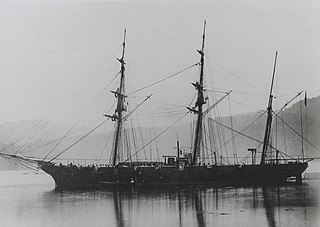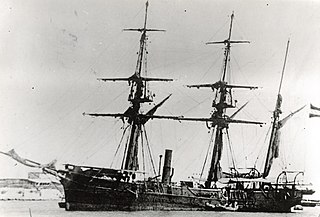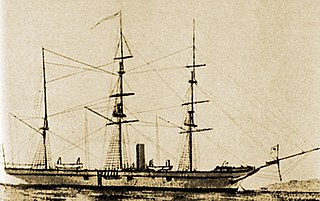
The Djambi class was a class of steam corvettes of the Royal Netherlands Navy. The class comprised Djambi, Zoutman, Willem, Leeuwarden, Metalen Kruis and Curaçao. Later two ships of a supposedly 'slightly revised' type were built, the Zilveren Kruis-class corvettes.

The Watergeus class was a class of screw sloop-of-war of the Royal Netherlands Navy. The class comprised the 'Watergeus' and the Marnix. A third ship that had been planned was cancelled.

The Zilveren Kruis class was a class of two steam-powered corvettes of the Royal Netherlands Navy. The class comprised Zilveren Kruis and Van Galen.

The Medusa class was a class of two steam corvettes with auxiliary power of the Royal Netherlands Navy. The class comprised Medusa, the first Dutch warship with screw propulsion, and Prinses Amelia.

HNLMS Wassenaar, was a unique ship built for the Royal Netherlands Navy.

The Evertsen class was a class of steam frigates of the Royal Netherlands Navy. The class comprised Evertsen and Zeeland

HNLMS Adolf van Nassau was a unique ship built for the Royal Netherlands Navy.

HNLMS De Ruyter, was a unique ship built for the Royal Netherlands Navy. She first served as a heavy sailing frigate. Next she was rebuilt as a steam frigate, but she was never finished as such. She was finally rebuilt and served as a Casemate ironclad comparable to the CSS Virginia.

The Vesuvius class was a class of steam screw sloops of the Royal Netherlands Navy. The class comprised Vesuvius, Cornelis Dirks, Reinier Claessen, Het Loo, Reteh and Prinses Maria.

Van Vlissingen en Dudok van Heel was a famous nineteenth-century Dutch machine factory. It built steam engines and machinery for the sugar industry and for maritime purposes, as well ships, rolling stock and large metal structures like the Moerdijk bridge and a floating dock. In 1871 it was reorganized to become the public company Koninklijke Fabriek van Stoom- en andere Werktuigen. In a second reorganization in 1890, parts of it were saved and continued under the name Koninklijke Nederlandsche Fabriek van Werktuigen en Spoorwegmaterieel, renamed to Werkspoor in 1927.

The Samarang class was a class of steam screw gunvessels of the Royal Netherlands Navy. The class originally comprised Samarang, Batavia and Makassar, but was later extended.

The Ever class was a class of 14 flat-iron gunboats of the Royal Netherlands Navy.

The Hector class was a class of 2 gunvessels of the Royal Netherlands Navy. The class proved a failure.

The Haarlemmermeer class was a class of nine gunvessels of the Royal Netherlands Navy. The class was a failure because of its extreme susceptibility to dry rot.

The Soestdijk class was a class of 8 gunvessels of the Royal Netherlands Navy. The class was built to the same design as the preceding Haarlemmermeer class, but proved far more durable.

The Bali class was a ship class of sloops of the Royal Netherlands Navy and Japanese Navy. The class comprised Bali, Kanrin Maru, Soembing and Chōyō Maru

The Ardjoeno class was a ship class of paddle-steamers of the Royal Netherlands Navy. The class comprised Ardjoeno, Gedeh (1850), Amsterdam and Gedeh (1874).

Vlissingen Navy Drydock is a dry dock in Vlissingen. It is the oldest dry dock of the Netherlands, and is now a tourist attraction known as Dok van Perry.

The Anna Paulowna class was a class of steam frigates of the Royal Netherlands Navy. Only Anna Paulowna was completed, parts of Van Galen were used to build the steam corvette Zilveren Kruis.

HNLMS Groningen was the lead ship of the Groningen class. She was one of the first Dutch purpose designed propeller driven warships, but was demolished after only 5 years of service.






















